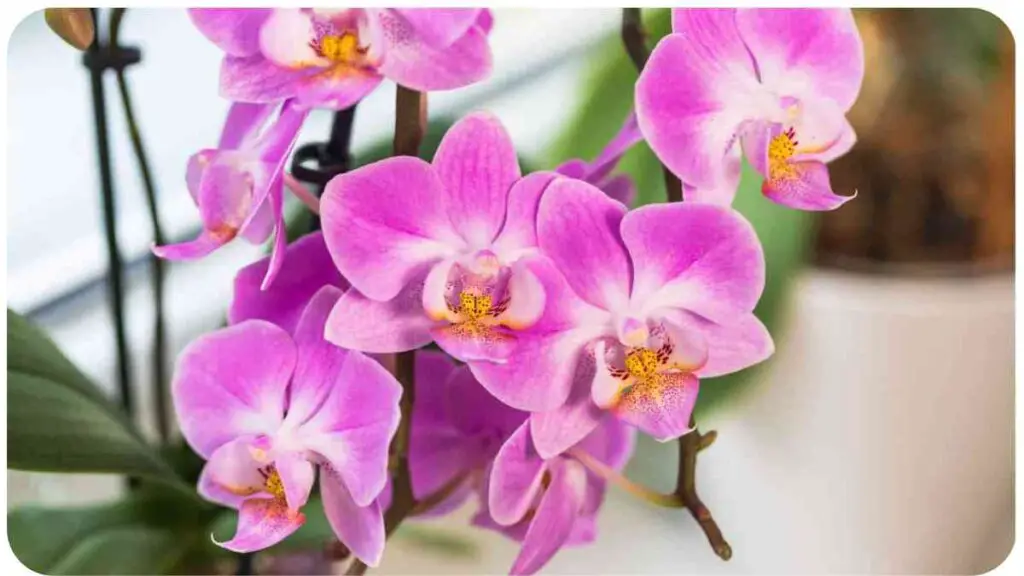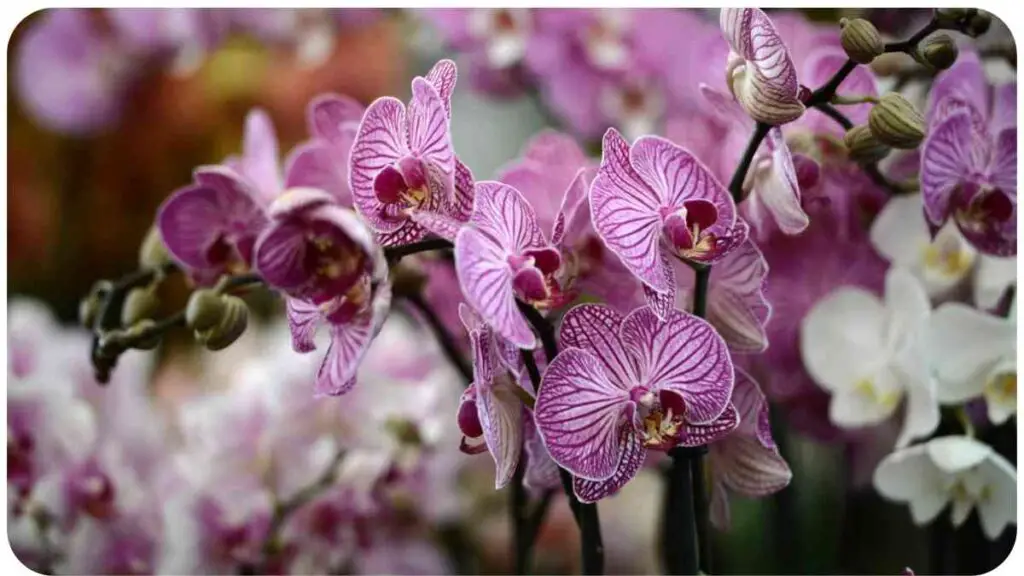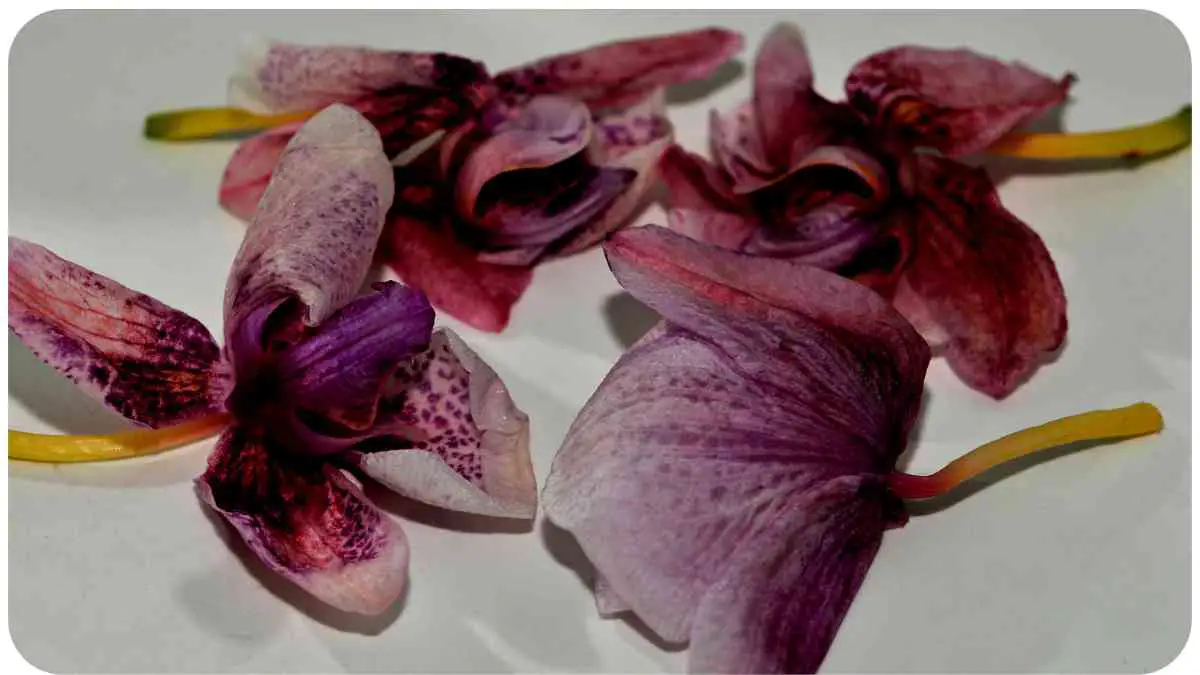Orchids, especially the Phalaenopsis variety, have always captivated our hearts with their intricate beauty. But seeing them wilt can be heart-wrenching. Trust me, I’ve been there. How can we breathe life back into these beauties?
| Key Takeaways |
|---|
| Understand the specific needs of your Phalaenopsis orchid. |
| Ensure proper watering, not letting the orchid sit in water. |
| Provide indirect sunlight for optimal growth and blooming. |
| Maintain a consistent temperature and humidity level for a thriving environment. |
| Repotting can provide a fresh start for orchids showing signs of distress. |
| When in distress, isolate, inspect, and act promptly to ensure orchid health. |
| Celebrate and cherish each bloom – it’s a testament to your care. |
| Post-bloom care, like pruning and understanding the rest period, is crucial. |
| Mistakes happen; learn from them and adjust your care routine accordingly. |
| Dive into further readings and communities for continuous learning in orchid care. |
| Each orchid’s journey is unique – cherish the learning opportunities and growth moments. |
Understanding Phalaenopsis Orchids
Phalaenopsis, or “Moth Orchids”, are among the most popular orchids globally. But why? Their prolonged blooming period, combined with their elegant look, makes them a household favorite. However, as much as they’re loved, they’re often misunderstood. Let’s dive deeper into their care!
If you’ve noticed your succulents drooping, don’t worry—there’s hope for revival. Learn how to revive your desert gems with proper care techniques that will have them thriving again.
Identifying the Problem
Noticed your Phalaenopsis looking a bit droopy lately? Identifying the root cause is the first step to reviving it.
Common Signs of Wilting

Droopy leaves, yellowing foliage, or shriveled roots often indicate a distressed orchid. But, based on my experience, not all wilting is bad. Sometimes, it’s just the orchid’s natural cycle.
Table: Differences between Healthy and Wilting Orchids
| Characteristic | Healthy Orchid | Wilting Orchid |
| Leaves | Firm and green | Yellow, droopy, or spotted |
| Roots | Green or silvery-white, firm | Brown, mushy, or shriveled |
| Blooms | Lasts for weeks/months | Falls off prematurely |
Understanding Orchid Watering Techniques
Watering orchids isn’t like watering other houseplants. These beauties have unique requirements.
The Ice Cube Myth
Oh, how many times have I heard, “Just put an ice cube a week, and you’re good”? Too many to count! Using ice cubes might seem like an easy hack, but it’s not ideal for tropical plants like Phalaenopsis. Remember, they’re from warm rainforests, not chilly ice lands.
Proper Watering Techniques
Drenching the roots and then allowing them to dry is the key. Over my years of growing Phalaenopsis, I’ve found that it’s better to slightly underwater than overwater. Wait for the potting medium to be almost dry before watering again.
Gardenias suffering from fertilizer overload? Discover the signs and effective solutions to bring your gardenias back to health with the right care and attention
Optimizing Light Exposure
Orchids adore light, but the right kind of light. Too much direct sunlight? You’re in trouble. Too little? Equally problematic.
Table: Ideal Light Conditions for Phalaenopsis
| Location | Light Intensity | Ideal Duration |
| East-facing window | Moderate morning light | 3-4 hours daily |
| West-facing window | Bright indirect light | 4-6 hours daily |
| South-facing window | Filtered light all day | Use sheer curtains or shades |
Perfecting Humidity and Temperature
Your orchid’s environment is more than just its soil and pot. Humidity and temperature play huge roles in its health.
Finding the Right Humidity Level
Phalaenopsis orchids thrive in 60-70% humidity. Living in a drier area? Consider getting a humidity tray or a room humidifier. I recall my early orchid days in a dry apartment; a simple humidifier was a game-changer!
Temperature Needs and Fluctuations
Phalaenopsis prefers temperatures between 65°F (18°C) at night and up to 80°F (27°C) during the day. A sudden cold draft or heatwave can shock them, so always keep them away from vents, heaters, and drafts.
Choosing the Right Soil and Pot
Just like you need the right shoes to walk comfortably, orchids need the right soil and pot to grow healthily.
Characteristics of Ideal Orchid Soil
Orchids need well-draining soil. Over the years, I’ve tried various mixes and found that a blend of bark, perlite, and charcoal works wonders for Phalaenopsis.
Table: Types of Orchid Pots and Their Advantages
| Pot Type | Advantages |
| Clear plastic pots | Allows monitoring of roots; good drainage |
| Clay/terra cotta | Provides good aeration |
| Slatted wood | Mimics natural growing conditions |
Remember, orchids are epiphytes in the wild, meaning they grow on trees. They’re used to air circulation around their roots, so always choose a pot that mimics their natural environment. The first time I swapped to a clear pot, I was amazed by the root growth!
Dealing with pesticide burn in your garden? Explore the world of organic remedies to rescue your plants and maintain a thriving, chemical-free garden.
Fertilizing Your Orchid

Food is essential for all living beings, and orchids are no exception. But with them, it’s not as simple as just dumping some fertilizer and calling it a day.
The Right Fertilizer Mix
There’s a saying in the orchid world: “weakly, weekly.” This means that you should feed your orchids weekly but with a weak fertilizer solution. A balanced 20-20-20 fertilizer diluted to 1/4 strength works wonders for Phalaenopsis orchids. Remember, my first blooming spike after consistent fertilizing? Absolute magic!
Signs of Over-Fertilization
Brown leaf tips or salt buildup on the pot’s surface indicate too much fertilizer. If this happens, give your orchid a good flush with plain water.
Dealing with Pests and Diseases
Pests and diseases can be a nightmare for orchid growers. Trust me; I’ve had my fair share of battles.
Common Orchid Pests
From spider mites to mealybugs, orchid pests can be a hassle. The key? Regular inspections. Every time I water my orchids, I inspect the leaves, stems, and roots for any signs of pests.
Table: Common Orchid Diseases and Solutions
| Disease | Symptoms | Solutions |
| Crown rot | Darkened, mushy crown | Avoid water in the crown; fungicide if necessary |
| Root rot | Brown, mushy roots | Repot and trim affected roots |
| Bacterial brown spot | Wet, brown spots on leaves | Cut affected area; use bactericide |
Repotting Your Orchid
Repotting is more than just giving your orchid a new home; it’s an opportunity to inspect the roots, refresh the potting medium, and encourage new growth.
Are your daffodils wilting prematurely? Get answers with this step-by-step troubleshooting guide to ensure your daffodils bloom beautifully.
When to Repot?
Once every 2-3 years is a good rule of thumb. But always repot if the potting medium breaks down or if you notice signs of disease or pests. I still recall repotting my first orchid—nerve-wracking, but so rewarding when it thrived afterward.
Steps to Repotting Safely
- Choose the right-sized pot (not too large).
- Prepare your potting mix.
- Gently remove the orchid, trim dead roots, and position it in the new pot.
- Fill with the potting medium, ensuring roots are snug but not compressed.
Regular Maintenance and Checkups
Orchids aren’t set-and-forget plants. They require regular care and attention. Over my years of caring for orchids, I’ve set a routine. Every weekend is orchid day!
Troubled by brown leaves on your Monstera? Dive into this comprehensive troubleshooting guide and discover effective solutions for healthier foliage.
Monitoring Growth and Blooms
Track your orchid’s growth. Are new leaves or roots emerging? Is a blooming spike forming? Celebrate the small wins!
Table: Monthly Orchid Care Checklist
| Week 1 | Week 2 | Week 3 | Week 4 |
| Watering | Fertilizing and watering | Watering | Inspect for pests/diseases |
| Check for pests | Rotate pots for even growth | Prune dead leaves/flowers | Watering |
Regular check-ins help you stay ahead of potential problems and ensure your Phalaenopsis orchid thrives.
Reviving Severely Affected Orchids
Even with the best care, sometimes orchids can take a turn for the worse. But don’t despair; I’ve brought back orchids from the brink, and so can you!
Immediate Steps for Recovery
- Isolate: Keep the affected orchid away from others to prevent potential disease spread.
- Inspect: Examine the entire plant for signs of disease, pests, or root rot.
- Act: Based on your findings, take appropriate measures, like cutting off affected areas or treating with appropriate solutions.
Table: Recovery Techniques Based on Symptoms
| Symptom | Immediate Action | Long-Term Care |
| Yellowing leaves | Ensure proper watering techniques | Adjust light and humidity |
| Droopy leaves | Check for root rot; repot if needed | Monitor watering and feeding |
| Brown leaf tips | Reduce fertilizer strength | Flush soil monthly to avoid salt buildup |
Personal Anecdotes
Orchid care is as much about experience as it is about knowledge. Let me share some of my own tales from my orchid journey.
My First Wilting Orchid Experience
I still remember my first Phalaenopsis orchid—a gorgeous white bloom. But, to my horror, it began to wilt within a week. I overwatered, kept it in direct sunlight, and did everything an orchid newbie could get wrong. Yet, with some research and lots of love, it bounced back the next season with even more vibrant blooms. It taught me the resilience of these plants.
Lessons Learned from Years of Growing Orchids
- Patience: Orchids teach you to wait. They won’t always bloom on your timeline.
- Observation: The more you observe, the more you understand their needs.
- Experimentation: Not all orchids are the same. Sometimes, you have to tweak care routines based on the specific orchid and its environment.
Additional Resources and Tools
Growing your knowledge is as crucial as growing your orchids. Always keep learning.
Books and Websites for Orchid Enthusiasts
- “The Orchid Whisperer” by Bruce Rogers: My go-to guide when I started.
- OrchidBoard: An online forum where orchid lovers share tips and tricks.
Table: Top Orchid Care Tools Every Grower Should Have
| Tool | Purpose |
| Humidity tray | Maintains optimal humidity levels |
| Balanced fertilizer | Feeds the orchid with necessary nutrients |
| Orchid potting mix | Provides a good environment for roots |
| Pruning shears | For trimming roots, leaves, and flower spikes |
Remember, each Phalaenopsis orchid is unique, and what works for one might not work for another. It’s a journey of discovery, joy, and sometimes, a little heartbreak. But every challenge only adds to the beauty and satisfaction of seeing them bloom.
Celebrating Orchid Blooms
There’s nothing quite like the satisfaction of seeing your Phalaenopsis orchid burst into bloom. Those magnificent flowers are a testament to your care and dedication.
Duration of Blooms
A well-taken-care-of Phalaenopsis can stay in bloom for up to three months! I’ve had some that bloomed even longer. It’s such a delightful sight to wake up to every morning.
Table: Factors Influencing Bloom Duration
| Factor | Influence on Bloom Duration |
| Light levels | Optimal light can prolong bloom time |
| Temperature stability | Consistent temperatures prevent premature wilting |
| Humidity | Helps in keeping blooms fresh and vibrant |
| Proper feeding | Ensures long-lasting, healthy blooms |
Post-Bloom Care
Once your orchid has finished blooming, it’s not the end. Proper post-bloom care can set your orchid up for even more spectacular blooms in the future.
Pruning Flower Spikes
Do you cut the spike, or do you leave it? It’s a question I’ve been asked countless times. If the spike turns brown or yellow, trim it down. But if it remains green, there’s a chance for a secondary bloom!
Rest Period
Phalaenopsis orchids generally have a rest period after blooming. This doesn’t mean they’re dormant; they’re just gathering energy for the next growth cycle. It’s vital to continue caring for them, just perhaps with a bit less water and fertilizer.
Common Mistakes to Avoid
Everyone makes mistakes, especially when starting. Here are some common ones to watch out for.
Table: Common Orchid Care Mistakes and Their Solutions
| Mistake | Solution |
| Overwatering | Wait until the top inch of soil is dry |
| Using standard potting soil | Opt for orchid-specific mixes |
| Keeping orchids in direct sunlight | Use sheer curtains or move to indirect light |
| Ignoring signs of pests/disease | Regularly inspect and take immediate action |
Conclusion: Embrace the Orchid Journey
Orchid care, especially for the Phalaenopsis variety, is both an art and a science. It involves patience, observation, and a willingness to learn from both successes and setbacks. As someone who’s grown orchids for years, I can assure you that every moment, from the nervousness of repotting to the thrill of a new bloom, is worth it.
Remember, every orchid has a story. It’s not just about the destination (those beautiful blooms) but also the journey of getting there. Embrace it, cherish the learning opportunities, and celebrate your orchid’s growth and resilience. Because, at the end of the day, isn’t that what gardening is all about? Enjoy the journey, Phalaenopsis lovers!
Further Reading
Orchid care can be a delightful journey, and there’s always more to learn. For those eager to dive deeper, I’ve curated a list of insightful articles that can further guide you on nurturing your Phalaenopsis orchids.
- Gardenstead: Orchid Care – Soak it Back to Life
- Dive into this detailed guide that discusses the soaking technique, an essential step to rejuvenate a wilting orchid.
- WikiHow: How to Revive an Orchid Plant
- WikiHow offers a visual step-by-step guide, complete with images, to help you breathe life back into a fading orchid.
- Ohio Tropics: Fixing Droopy and Wrinkled Orchid Leaves
- Understand the causes behind droopy and wrinkled leaves and learn effective strategies to restore their former glory.
FAQs
Diving into orchid care can be a journey filled with questions. Let’s tackle some common ones based on the essence of our article “Reviving Your Wilting Orchids: Tips and Techniques for Phalaenopsis Lovers.”
Why is my Phalaenopsis orchid wilting?
Wilting can be a result of multiple factors, from overwatering to inadequate light. It’s crucial to evaluate the orchid’s environment and care routine to pinpoint the cause.
How often should I water my orchid?
The golden rule is to water when the top inch of the potting medium feels dry. Overwatering is a common mistake, so ensure the roots have time to breathe between waterings.
Can an orchid bloom more than once on the same spike?
Yes, if the spike remains green after the orchid has bloomed, there’s a chance for a secondary bloom. It’s nature’s encore!
What’s the best potting mix for Phalaenopsis orchids?
Avoid standard potting soil. Instead, opt for orchid-specific mixes that provide the right aeration and drainage for the delicate roots.
I found pests on my orchid! What do I do?
First, isolate the affected orchid. Regularly inspect the plant and treat it using appropriate measures, such as insecticidal soap or neem oil, depending on the type of pest.

I am Hellen James, a landscape architect. For many years I have written about landscaping for various publications; however, recently decided to focus my writing on personal experience as a profession.


